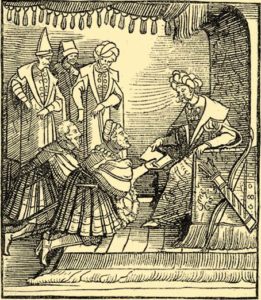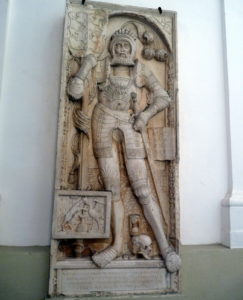20 March 1528 The Battle of Szina
The battle of Szina was fought between the soldiers of King Habsburg Ferdinand and King Szapolyai János near Kassa (Kaschau, Kosice), and it was a conclusive fight because King Szapolyai had to flee to Poland, and had to accept the help of Sultan Suleiman. Let us look into the road between the battlefield of Mohács (1526) and the field of Szina, and see how the bloody period of the Dual Kingship commenced in the Kingdom of Hungary.

As we know, the young King Lajos II died in the battle of Mohács on 29 August 1526, and Sultan Suleiman won the fight. At that time, Szapolyai János was the Voivode of Transylvania, and he and his about 15.000 men could not get to Mohács in time to help the monarch. I do believe that Szapolyai tried hard to get there, he even took on a fast coach and left his troops behind but he was just too late. However, his brother, Szapolyai György (1488-1526) was on King Lajos’ side and died in the battle. According to the contemporary historian, Szerémi György, it was Szapolyai György who actually killed the young king while fleeing, and he was also cut down afterward. This theory is not accepted by academic Hungarian historians, though.

Queen Habsburg Maria, wife of late King Lajos II fled from Buda, and soon she was helped by her brother, Ferdinand. According to the Habsburg-Jagiellonian treaty of 1515, Ferdinand claimed the Hungarian throne as his. For the time being, only a few Hungarian noblemen supported his claim, though. The majority of the noblemen elected a native Hungarian King, he happened to be Szapolyai János. He was properly crowned and after Suleiman left the country, he took over the command almost everywhere.

At first, he had to break down the bloody uprising of the Serbian Cerni Jovan, Jovan was supported by Habsburg Ferdinand in 1527, you can read more about this on my page in detail:
https://www.hungarianottomanwars.com/1490-1541/1527-cserni-aka-black-or-nenad-jovans-uprising/
As for the Turks, it was not coming from evil to negotiate with the Sultan: the French and the Polish examples can show it clearly, not to speak of the Venetians. There was only one person who had objected to all sorts of negotiation with the Ottomans, it was Queen Maria: instead, she had to know that she was sending her husband to certain death, despite her deep love. Habsburg dynastic interests came first, and Hungary had to be gained. Note, that the Habsburgs had not sent any soldiers to King Lajos II, but Ferdinand was quick to raise an army when he attacked Hungary after the Turks had been gone.

In the meantime, King Szapolyai had to do something with the Ottomans, and he sent his very talented and brave Polish diplomat, Hieronymus Łaski to Sultan Suleiman. Lasky succeeded in allying with the Ottoman Empire without turning Hungary into a vassal state that would pay taxes to the Sultan. These were the two hard conditions that had been given to him by King Szapolyai. Yet, the Sultan upheld his claim for Hungary and offered military help against the Habsburgs. The Sultan fixed his eyes on Vienna, the desirable Gold Apple, his attention was distracted from the rest of Hungary for the time being. As we can see, it was a grave mistake, Suleiman could not get through the Hungarian Borderland castles and died at Szigetvár in 1566 without gaining Vienna. You can read more about Lasky’s negotiations in detail here:
https://www.hungarianottomanwars.com/1490-1541/1527-the-negotiations-of-sir-lasky-in-istanbul/
Ferdinand was able to have himself crowned as King of Hungary, and the Dual Kingship tore the kingdom into two parts. His army also proved to be stronger and gradually forced Szapolyai to the East. Then, he won a decisive battle against him at Tarcal, near Tokaj on 27 September 1527. I described this battle in my book “33 Castles, Battles, Legends”. Szapolyai had to withdraw to Transylvania where he tried to reorganize his army during the winter of 1528. He planned to launch a counterattack in the spring,

There were many Polish soldiers in Szapolyai’s new army, along with Transylvanian and Serbian warriors. His units set out to take Eger castle back from Ferdinand but this part of his army was defeated by the troops led by Török Bálint, Bakics Pál, and Pekry Lajos. (Please, note that I use the Oriental name order for Hungarians where family names come first,) Even King Szapolyai’s general was captured. The second part of the army was commanded by King Szapolyai, he targeted Kassa city. On the way there he defeated the army of Perényi Péter and took Sárospatak and Sátoraljaújhely as well. Behold, Perényi was a very interesting historical figure, he represented the “third-way” politics in Hungary. You can read more about Perényi here:
https://www.hungarianottomanwars.com/essays/lord-perenyi-peter-1502-1548-part-one/

From Kassa (Kosice, Kaschau), King Szapolyai set out with his 14.000-strong army against Ferdinand’s general, Johann von Katzianer. Unfortunately, hostility broke out in Szapolyai’s army between the Polish and the Serbian mercenaries but Szapolyai continued the campaign. He crossed the Hernád River and he met the army of Katzianer at Szina (Abaújszina, Seňa). The army attacked but the German landsknechts were very well-disciplined and their pike-and-shot warfare withheld the cavalry. The Polish infantrymen fought for the longest time but the Germans finally took the cannons of Szapolyai. It was the turning point of the battle. The fleeing army suffered huge casualties, 300 Polish soldiers died, and several thousand from other units. King János was also almost captured.

The runners were chased by the riders of Pekry and Török Bálint, and they defeated the remaining army of Szapolyai on 25 March. The defeat at Szina largely contributed to the alliance between King Szapolyai and Sultan Suleiman. As it turned out, the Ottomans came to Szapolyai’s aid the next year with a large army. The Turks chased the Habsburgs out of Buda, then, they gave the capital back to Szapolyai.

Source: based on Szibler Gábor’s article
Dear Readers, I can only make this content available through small donations or by selling my books or T-shirts.
If you like my writings, please feel free to support me with a coffee here:
You can check out my books on Amazon or Draft2Digital, they are available in hardcover, paperback, or ebook:
https://www.amazon.com/dp/198020490X
or at https://books2read.com/b/boYd81


My work can also be followed and supported on Patreon: Become a Patron!http://Become a Patron!



